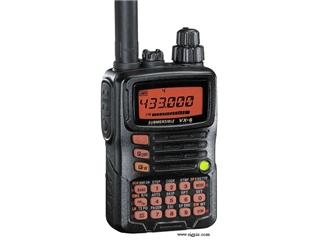icestorm81
Member
@mmckenna
Thanks for your detailed feedback! I decided to go ahead with a ham radio.
I will be doing more research on this but if you have any suggestions on how to find repeaters in any area then please let me know. I presume I will also have to set it up on my side.
I already have a BCA Radio: BCA BC Link™ Two-Way Radio 2.0 | Backcountry Access
I presume BCA radio is similar to a V3MR or a V10MR. From a price perspective, BCA seems to be a bit more expensive. Here is the link that I had come across when researching best ways to communicate while mountaineering:
The other thread i came across was from this forum (i just noticed):

 forums.radioreference.com
forums.radioreference.com
ICOM support had also recommended V10MR and V3MR (license free) along with ID-52A and T10 (for HAM).
Agreed. BCA radio is quite easy to use. I would be running a test to see how the BCA radio performs against the VX-6R.
Not sure if the VX-6R has a lock feature but that maybe useful to prevent any accidental button press. The knobs would still be an issue but that is on BCA radio as well. I like tech so it will be fun to use and something new to learn.
I had ordered Yaesu VX-6R (2 sets -- already received them; it was surprisingly a quick delivery). I had also considered FTD5 but was recommended VX-6R for its ruggedness. If you have any thoughts on VX-6R vs. FTD5 then please share. I could not find any comparisons between the two online.
I am planning to order extra batteries for VX-6R. I see this as a positive since the BCA radio did not have the option to replace/swap a battery.
I am also going to order a diamond antenna: SRH-77CA and will be looking at other accessories as well. If you have any other suggestions for accessories then please let me know.
I mainly want to use it as a walkie talkie so if there are any good sources that you can recommend for learning then feel free to share them along with any other features you think i should look into for my use. I doubt if passing the technician test would help me to learn on how to use HAM radio along with all its features. I plan to look at the manual + online/youtube.
I believe i read somewhere that you have the option to remotely transmit to your partners radio...that sounds like a useful feature to have if it is possible.
These are the accessories listed on HRO page for VX-6R:

I think i will also get the manual and perhaps the programming SW / cable.
Good to know but as you said Garmin is the right device for emergencies.
Thanks for your detailed feedback! I decided to go ahead with a ham radio.
Accessing repeaters can be handy if you are in range of one, it'll greatly increase your coverage, but they do not cover every inch of the country, especially out here in the west.
I will be doing more research on this but if you have any suggestions on how to find repeaters in any area then please let me know. I presume I will also have to set it up on my side.
Other option would be to get some MURS radios. These don't require you taking a test to get a license. You don't need to pay for a license, either. FCC calls it "License by Rule", which translates into "If you follow the rules, you are good to go".
MURS is only legal to use in the USA, but that doesn't sound like an issue for you.
It uses 5 VHF channels, and VHF tends to work well in more rugged terrain.
It's limited to 2 watts, but don't get hung up on that. Transmitter power output doesn't impact range as much as you would think. Very little difference between a 2 watt MURS radio and a 5-6 watt ham radio.
Benefit is that since there is no license required, you can hand them to anyone and you're good to go.
Icom makes some really nice MURS radios:
V3MR Multi-Use Radio Service (MURS) Transceiver - Features - Icom America
www.icomamerica.com
V10MR Multi-Use Radio Service (MURS) Transceiver - Features - Icom America
www.icomamerica.com
One other HUGE benefit to MURS:
The radios are simple to use. On/Off/Volume control and a channel selector. Channels are already programmed, so it is essentially a case of charging the batteries, turning the radios on, setting them all to the same channel, and you are done.
I already have a BCA Radio: BCA BC Link™ Two-Way Radio 2.0 | Backcountry Access
I presume BCA radio is similar to a V3MR or a V10MR. From a price perspective, BCA seems to be a bit more expensive. Here is the link that I had come across when researching best ways to communicate while mountaineering:
Icom Two Way Radios Summit Mt. Everest - News - Icom UK
Icom two way radios have sailed the ocean, flown the sky, and now they’ve climbed the highest peak on earth. In May, a climbing team led by Mountain Link, a Bend, Ore.-based mountaineering guide service, summited Mt. Everest with Icom radios in hand. At 29,035 feet in elevation, Mt. Everest is...
icomuk.co.uk
The other thread i came across was from this forum (i just noticed):
Radio for mountaineering
Hi everyone, I am a climber looking for a radio for mountaineering. Last year I was on Aconcagua and most teams were using radios for weather updates and logistics. This year I am going to climb Mont Blanc in France/Italy, Mount Elbrus in Russia, and a couple other peaks in Kosovo, Albania and...
ICOM support had also recommended V10MR and V3MR (license free) along with ID-52A and T10 (for HAM).
Agreed. BCA radio is quite easy to use. I would be running a test to see how the BCA radio performs against the VX-6R.
One of the biggest issues I see with many new users to ham radio is that it is really easy to bump the controls on a ham radio and end up not being able to communicate. The complexity of the ham radios is great if you are into the technical side of it, but its a pain in the rear when you just want to talk to someone. Fumbling around with tiny keys on a radio and trying to read an LCD screen in the bright sunlight will frustrate many users, and getting off into a corner of the radio where you can no longer communicate can be a safety risk.
It would be up to you to decide how much technical stuff you want to get involved in. Ham radio is great, but it's complex. It's designed that way for experimenters and enthusiasts. For someone who just wants to talk to another person, something like MURS can be a much better choice.
In my career, I have to set up a lot of radios for users that are not "radio people". I learned quickly to make sure the radios are set up as simply as possible. It makes for a much better user experience, and less trouble calls….
If tech is your thing and you really want to get into the hobby, then ham radio is a great option. It has a steep learning curve, and that is a problem for some. Nothing wrong with that, but the frustration it creates is something to consider.
Being able to talk to others via ham radio can be interesting for some. It's part of the hobby that many enjoy. From a high mountain, you could talk to others hundreds of miles away easily.
Not sure if the VX-6R has a lock feature but that maybe useful to prevent any accidental button press. The knobs would still be an issue but that is on BCA radio as well. I like tech so it will be fun to use and something new to learn.
The Yaesu's may be a good choice if that's the direction you want to go. Yaesu is a well respected company, and you'll get lots of good support. Their radios are pretty durable and will likely work well for what you want.
I had ordered Yaesu VX-6R (2 sets -- already received them; it was surprisingly a quick delivery). I had also considered FTD5 but was recommended VX-6R for its ruggedness. If you have any thoughts on VX-6R vs. FTD5 then please share. I could not find any comparisons between the two online.
Only other thing you'd want to consider is making sure you can keep the radios running if you are out for a long time. Charging batteries in the field can be hard to do. The more complex a radio is, the more power it will use, the more batteries it will eat. A radio with a dead battery doesn't do anyone any good. Carrying spare batteries is an option, but consider the additional weight. Solar chargers may let you charge a spare set while you are hiking. The Yaesu gives you the option of using AA alkaline cells in a separate battery case, which can be beneficial.
I am planning to order extra batteries for VX-6R. I see this as a positive since the BCA radio did not have the option to replace/swap a battery.
I am also going to order a diamond antenna: SRH-77CA and will be looking at other accessories as well. If you have any other suggestions for accessories then please let me know.
I mainly want to use it as a walkie talkie so if there are any good sources that you can recommend for learning then feel free to share them along with any other features you think i should look into for my use. I doubt if passing the technician test would help me to learn on how to use HAM radio along with all its features. I plan to look at the manual + online/youtube.
I believe i read somewhere that you have the option to remotely transmit to your partners radio...that sounds like a useful feature to have if it is possible.
These are the accessories listed on HRO page for VX-6R:

YAESU VX-6R
144 / 220 / 430 MHz 5 Watt / 1.5W (220) Hand Held FM Transceiver - JIS7 Submersible
www.hamradio.com
I think i will also get the manual and perhaps the programming SW / cable.
Also, since I'm sure someone will bring it up:
A lot of people get into amateur radio for "emergencies". The idea that you can raise someone from just about anywhere and get help.
That's certainly an option and does happen frequently.
Just keep in mind, ham radio is a hobby, and there is zero requirements that anyone be listening. There are zero requirements that even if someone is listening, that they'll help you out. You are dealing with hobbyists, not professionals.
The Garmin is the right device for your emergency needs. The radios are for the convenience, either MURS or ham.
Good to know but as you said Garmin is the right device for emergencies.
Last edited:

